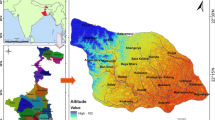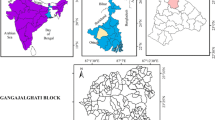Abstract
In the present study efforts have been made to evaluate ground water potential zones for ground water targeting using IRS-IC LISS-II1 geo-coded data on 1:50,000 scale. The drainage, geology, geomorpholgoy and lineament information has been generated and integrated to evaluate hydro-geomorphological characteristics of the Gairnukh watershed, Bhandara district, Maharashtra for delineation of ground water potential zones. The analysis reveals that the deep valley fills with thick alluvium have excellent, shallow valley tills and deeply weathered pediplains with thin alluvium have very good and moderately weathered pediplains in the geological formations of Tirodi Gneiss and Sausar Groups have god ground water potential and these units are highly favourable for ground water exploration and development. Shallow weathered pediments in geological formations of Tirodi Gnesis and Sausar Groups are marked under moderate ground water potential zone. Shallow weathered pediplains in geological formations of Tiridi Gneiss and Sausor Groups are grouped under limited ground water potential category, except along the fractures/lineaments. Structural hills in geological formations of Tirodi Gneiss and Sausar Groups have poor ground water prospects. Inselbergs and Linear ridges in geological formations of Tirodi Gneiss are grouped under very poor ground water prospects zone. The good inter-relationship was found among the geological units, geomorphological units, lineament density, hydro-geomorphological zones and ground water yield data.
Similar content being viewed by others
References
Behera SC (1989). Hydro-geomorphological studies in parts of Baitarni Basin. Keonjhar district, Orissa using remote sensing Techniques. A report on training project at IIRS Dehradun.
BhattacharyaA and Reddy PR (1991). Hydrogeomorphological mapping for ground water prospects in India using IRS imagery. How to meet the demand of drinking water. In Remote sensing in Asia and oceania-Environmental change and monitoring (ed. Shunji Murai). Asian Association of Remote Sensing Tokyo, Japan.
Central Ground Water Board (CGWB) (1999). Report on the hydrograph network stations in Bhandara district, Maharashtra, period (1978-98). (Nagpur: Central Ground Water Board)
Chattreji PC Surendra Singh and Qureshi LH (1978). Hydro-geomorphology of the central Luni basin, western Rajasthan, Indian Geoforum, 9:211–214.
Dept. of Space (1988). Preparation of hydrogeomorphological maps of India on 1:250,000 scale using satellite Imagery, project document National Technology on Drinking water, Dept. of space 83p.
GSI (1978). Geological Quadrangle map of Topographical Sheet 550 (Nagpur):Madhya Pradesh-Maharashtra, Geological Survey of India, 1978.
Haridas VK, Chandra Sekaran VA, KumaraswamyK, RajendranS and Unni Krishnan K (1994). Geomorphological and lineament studies of Kanjamalai using IRS-IA data with special reference to ground water potentiality, Trans. Instt. Indian geographers, 16(1):35–41.
Krishna MurthyJ and SrinivasG (1995). Role of geological and geomorphological factors in ground water exploration-a study through remote sensing techniques, Int. J. Remote Sensing, 16, 2595–2618.
Krishnan MS (1982). Geology of India and Burma, Edison (IV):1–536.
Obi Reddy GP, Suresh Babu R and Sambasiva Rao M (1994). Hydro-geology and hydrogeomorphological conditions of Anantapur district, using Remote sensing data. Indian Geog. J., 69 (2):128–135.
Pradeep Raj, Nand Lal L and Soni GK (1996). Nature of aquifer in parts of granitic terrain in Mahaboob nagar dist., A.P. Geol. Soc. India, 48(3):299–307.
Rao DP BhattacharyaA and Reddy PR (1996). Use of IRS.1C data for Geological and Geographical studies. Curr. Sci. Special Session:IRS-lC, 70 (7): 619–623.
Ravindran KV and JeyaramA (1997). Ground water prospects of shahbad Tehsil, Baran district, Eastern Rajasthan and Remote Sensing Approach. J. Indian Soc. Remote Sensing, 25(4):239–246.
Reddy PR (1987). Geological and Geomorphological studies through remote sensing. In special volume of COSTED Remote Sensing Technology for Natural Resources.
Reddy PR, Vinod KumarK and SeshadriK (1996). Use of IRS-1C data in ground water studies. Curr. Sci. Special Session:IRS-lC, 70 (7):600–605.
Saraf A.K. and Choudhary PR (1998). Integrated remote sensing and GIS for ground water exploration and identification of artificial recharge sites, Int. J. Remote Sensing, 119(10):l825–1841.
Seelan Santhosh Kumar and Thiruvengadachari S (1980). An integrated regional approach for delineation of potential ground water zones using satellite data-an Indian case study. Abstracts of proc. 26th International Geological congress Paris, July 1980.
Author information
Authors and Affiliations
About this article
Cite this article
Reddy, G.P.O., Mouli, K., Srivastav, S.K. et al. Evaluation of Ground Water Potential Zones Using Remote Sensing Data -A Case Study of Gaimukh Watershed, Bhandara District, Maharashtra. J Indian Soc Remote Sens 28, 19–32 (2000). https://doi.org/10.1007/BF02991858
Received:
Revised:
Issue Date:
DOI: https://doi.org/10.1007/BF02991858




